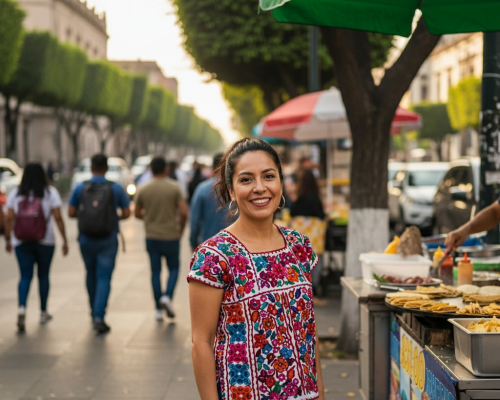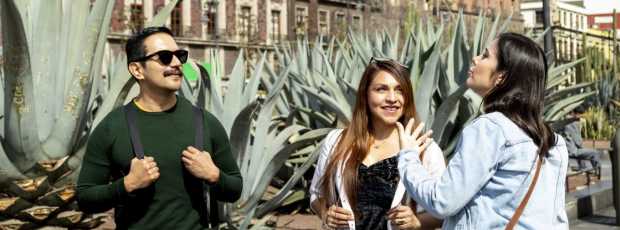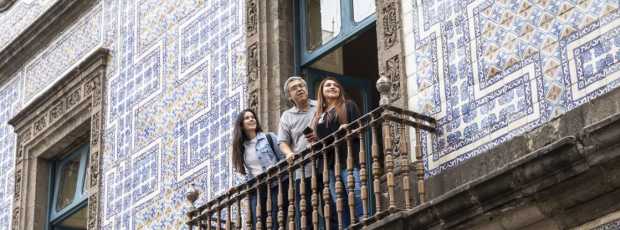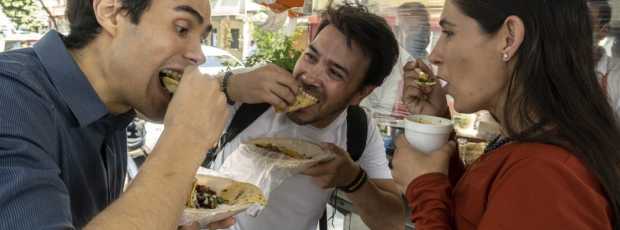The tour is extremely customizable and we were able to select everything we wanted to do and see based on our interests.Sarah, Mexico City, 2025
Table Of Contents
- Where Do Locals Escape the City Center Crowds?
- Which Museums and Libraries Still Feel Hidden?
- Where's the Best Street Food Off the Beaten Path?
- What's a Real Lucha Libre Match Like for Families?
- Where Can You Find Pine Trails Without Leaving the City?
- Which Archaeological Site Beats the Crowds?
- What Should You Skip, or See Differently?
- How Do Locals Move Between Gems?
- Frequently Asked Questions
- Final Thoughts
Locals don't call these gems hidden. We call them life.
I've spent thirty-four years walking these streets, from childhood tamale runs with my grandmother to showing visitors the Mexico City that lives between guidebook pages.
The real hidden gems in Mexico City aren't mystical corners. They are woven into our daily rhythms: morning coffee spots, Sunday markets, plazas where kids play fútbol while parents catch up over pulque.
A real visit to Mexico City shouldn't be about all the unusual things you can post on Instagram. It should be about stepping into the cadence of a city that breathes beyond its monuments.
I'll show you where locals actually go, when we go, and why these spots matter. Some require Metro rides to neighborhoods most tourists skip. Others hide in plain sight, which means you only need different timing.
The Mexico City I know doesn't put on a show for tourists. It's in the spaces between the famous stuff, in conversations over café de olla, and in the rhythm of street vendors calling out morning offerings.
If you're looking for comprehensive Mexico City experiences, these gems complement the must-see attractions perfectly.
Where Do Locals Escape the City Center Crowds?
I know Centro Histórico pulses with energy, but sometimes you need breathing room. I've found sanctuary spots in neighborhoods that feel like actual places to live, not just visit.

Quiet plaza in Santa María la Ribera with the Moorish kiosk at golden hour
Santa María la Ribera’s Moorish Kiosk: Small-Town Calm
Whenever I get the chance, I walk through Santa María la Ribera to decompress. The neighborhood wraps around its central plaza like a small town that accidentally landed in Mexico City. The Moorish Kiosk, designed by José Ramón Ibarrola for international expositions, was installed here in 1910.
Families spread blankets while teenagers practice skateboard tricks around the fountain. Ice cream vendors push carts along tree-lined paths, and old men gather for domino games. The pace moves differently. People actually sit and talk instead of rushing through photo stops.
Getting there: Metro Buenavista, then a 10-minute walk. Best time is late afternoon when light filters through the trees and families start evening routines.

Colonial Street in San Ángel
San Ángel Neighborhood Lanes Most Tourists Miss
San Ángel has a reputation problem. Everyone knows the Saturday market, but the real San Ángel neighborhood lives in cobblestone side streets where lava-stone walls line quiet residential blocks.
I take visiting friends through the lanes behind the main plaza, where bougainvillea spills over courtyard walls and small galleries occupy converted colonial houses. Café El Jarocho, close to San Ángel, serves coffee the way my grandmother remembers from Veracruz.
Local insight: Skip the Saturday market chaos. Come Tuesday or Wednesday mornings when galleries are quieter and the streets belong to residents walking dogs.
Mexico City is Not Just a Place on a List
Experience it through hidden corners and stories most visitors miss.

Tianguis in Portales market
Is Portales the Best Non-Touristy Sunday Tianguis?
I was taught that you judge a Mexico City neighborhood by its Sunday market. Portales delivers what famous markets used to be before they discovered tourism. This working-class neighborhood spreads its tianguis across several blocks, selling cookware, records, tools, and clothes people actually wear.
I come here for vinyl records at reasonable prices. Food vendors serve families making weekly rounds, not tourists hunting an authentic experience. The beauty lies in the complete absence of performance.
Practical note: Go on weekend mornings to the antiques tianguis on Rumania near Metro Portales. Many stalls wind down by midafternoon. Bring cash for conversations that assume cultural understanding.
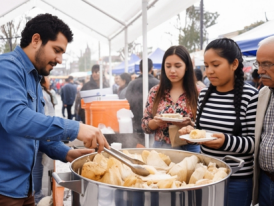
Tamale street stand
Roma Norte at 8 AM: Coffee Windows and Street Vendors
Before Roma Norte becomes a brunch destination, it belongs to residents. I walk these streets regularly before cafés fill with laptops and sidewalks crowd with mural photographers.
At 8 AM, street vendors position carts at Metro exits, selling coffee and tamales to downtown commuters. Neighbors walk dogs and stop for conversations that block sidewalks because connection matters more than efficiency.
When it works: Come before 9 AM, before the transformation begins. Walk residential streets, not main avenues. Buy coffee from street vendors, not Wi-Fi cafés.
Imagine Experiencing Roma for Real
A local can show you the vibe, flavors, and hidden gems of this neighborhood up close.
Which Museums and Libraries Still Feel Hidden?
Mexico City's famous museums earned their reputations but lost intimacy. I prefer cultural spaces where you can think, where crowds do not dictate your pace.
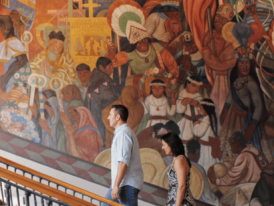
An iconic Diego Rivera mural
Antiguo Colegio de San Ildefonso for Early Diego Rivera
Everyone lines up at the Palacio Nacional to see Diego Rivera’s murals, then complains about crowds moving through the corridors. Instead of the Palacio Nacional, I take people to San Ildefonso, where Rivera painted some of his earliest and most personal work without tour bus pressure.
The building tells stories. Former students carved names into wooden benches. Rivera’s early murals show a style still developing, more intimate than the grand political statements at famous locations.
Insider timing: Tuesday mornings are nearly empty. It is a downtown Mexico City location, but it feels worlds away from National Palace crowds.

Biblioteca Vasconcelos interior catwalks and glass floors
Biblioteca Vasconcelos and Those Surreal Glass Floors
This library looks like science fiction built with books. The architect suspended reading areas on metal catwalks above a central void, creating the feeling that you are walking through space surrounded by millions of books.
You can walk along these metal-and-glass catwalks suspended among the stacks. It feels magical and awe-inspiring.
Library etiquette: Photography is allowed in common areas. Respect the study zones. Weekend afternoons bring families, which creates a community library feeling.
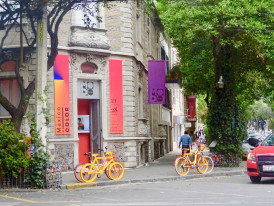
Eccentric exterior of the MODO museum
A Small Museum Duo: MODO vs. MUJAM
Instead of fighting crowds at the National Museum of Anthropology, I take design lovers to MODO and families to MUJAM. Both pack extensive collections and curiosity into spaces where you can actually see everything without museum fatigue.
MODO focuses on Mexican design through everyday objects. MUJAM houses a toy collection spread across the floors of a converted house. Both value curiosity over spectacle.

Entrance of Casa Gilardi by Luis Barragán
Is the Luis Barragan House Absolutely Worth the Additional Cost?
Yes, but only if it's really something you're interested. Architecture students treat the Luis Barragán House like a pilgrimage. Tours cost more, require advance booking, and group sizes are small. For people who understand space and light, it is revelatory.
The additional cost keeps crowds small, preserving the contemplative experience Barragán intended. The house demonstrates design principles that influenced architecture worldwide.
Worth it if: You care about architecture or how spaces affect emotion. Not worth it if you are box-checking cultural tourism. Museums should make you think, not just take photos.
Where's the Best Street Food Off the Beaten Path?
Famous food markets discovered Instagram. I eat where food matters more than atmosphere, where vendors focus on flavor over photos. Knowing what to eat in Mexico City is the biggest part of enjoying the place. I want you to forget about fancy restaurants and indulge in the food my friends and I love.
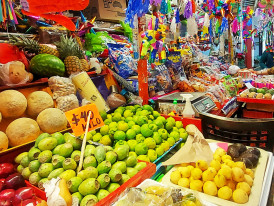
Fruit stalls with handwritten signs and shoppers
Mercado de Medellín's Latin America Flavors
Mercado de Medellín calls itself “Little Latin America.” Colombian vendors sell arepas next to Honduran baleadas, while Mexican stalls offer familiar comfort alongside South American discoveries.
I come for produce you rarely find elsewhere. Plantains from three countries, each with a distinct purpose. Chile varieties most Mexico City vendors do not carry. The local food scene pulls in flavors from across the continent.
What to order: Ask juice vendors for combinations popular in their home countries. Come hungry and curious.
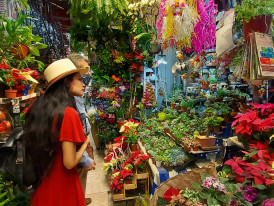
The Mercado Jamaica market flower stalls
Mercado Jamaica After Dark: Flowers + Street Food
While tourists hunt for the main Jamaica flower displays, I head to the food stalls locals actually use.
Doña Hortensia runs an elote and esquite stand where families stop while shopping. Her esquites asados come with habanero that will clear your sinuses, served in corn husks so you can sample other stalls without juggling containers.
Down the piñata aisle near the Morelos entrance, Don Juventino grills campechanos with house-made green chorizo and cecina from Morelos. His fixed market post serves mostly neighborhood clientele who come for quality-driven griddle tacos, not photo opportunities.
The blue-corn tlacoyo stand operates from the parking area doorway on weekends. Real nixtamal, cooked to order, zero hype. Expect a small wait because they make everything fresh. The tlacoyo de haba with salsa muy picante tastes like the ones my grandmother bought at markets decades ago.
Why this beats tourist night markets: Real market prices, family operations, food that serves daily hunger instead of Instagram curiosity.
Go mid-afternoon to evening when the market energy builds but crowds stay manageable.
Drooling For Mexico City's Food?
Let a local take you to all the best street food stops in the city

Row of suadero taco stands in Narvarte with Tacos al Pastor preparation
Narvarte Suadero Row vs. One "Famous" Taco Spot: Which to Pick?
Food magazines crown single vendors as the “best,” but I prefer the democracy of suadero clusters where multiple vendors compete on the same blocks. Narvarte hosts the most honest taco competition.
Four or five stands often line the same streets, each building loyal customers through subtle variations. Competition keeps everyone focused on quality instead of reputation.
Order one taco from a few different stands to compare approaches. Locals pick based on taste, not rankings.
Instead of chasing El Vilsito's Instagram fame, I take friends to the actual suadero cluster where Narvarte locals hop between stands comparing techniques.

Tacos de Suadero from Tacos Tony
Tacos Tony holds down one corner with a three-salsa lineup that changes based on what chiles look good that day. Late nights after shows, construction workers and night-shift nurses gather here for suadero, campechano, and lengua that costs what food should cost.
Two blocks over, Tacos Chepe operates 24 hours with suadero done the traditional way and volcanes when you want something crispy. Ask about off-menu cuts like picaña when they have it. The owner knows his regulars by their usual order, not their follower count.
Juan Bisteces rounds out the triangle, serving suadero the old way with Coca-Cola on the side like the regulars drink. The setup looks like nothing special because it focuses on the griddle, not the show.
Why this beats El Vilsito: No lines, no performance, just neighbors eating good food at working-class prices. Order one taco from each stand to compare approaches like locals do.
Try all three in one evening to understand why Narvarte locals don't need famous stands.

Tourists enjoying tianguis
Sunday Tianguis, Market Food Without the Hype
The Sunday tianguis on Rumania serves families doing weekly shopping, which means food vendors price for neighbors, not tourists. Mobile quesadilla stands cook fresh tortillas on comals while you wait.
Guisado taco vendors offer the stewed meats that actually fill you up. Atole carts push through the aisles with fresh, hot drinks that cost what drinks used to cost everywhere.
I come here with my own shopping rhythm: browse, taste, buy, repeat. Vendors expect conversations, not quick transactions. They'll recommend their neighbor's stand if they don't have what you want.
Why this beats famous markets: No performance, no markup, no lines. Just working-class commerce at working-class prices.
I recommend you go on Sunday mornings only, many vendors wind down by mid-afternoon. Bring cash and patience for proper market etiquette.
Hungry to Try Mexico's Delicious Food Yourself?
Taste and explore the flavors locals actually love.
What's a Real Lucha Libre Match Like for Families?
Arena México gets tourist attention, but families seeking authentic lucha libre might prefer smaller venues where the drama feels intimate and crowds include actual wrestling fans.

Arena Coliseo crowd during a lucha libre match
Arena Coliseo vs. Arena México: Timing and Seats
Arena Coliseo offers everything Arena México provides, scaled to neighborhood proportions. Wrestlers perform the same acrobatic theater, but you're close enough to see sweat and hear the impact.
Tuesday night matches come at the true price entertainment should cost - nothing more, nothing less. Children cheer for técnicos with genuine enthusiasm while adults debate storylines .that connect months of competition
Family logistics: For families, choose Saturday at 7:30 PM at Arena Coliseo or Sunday afternoon at Arena México. I recommend arriving 30 minutes early for snacks because matches start on time.
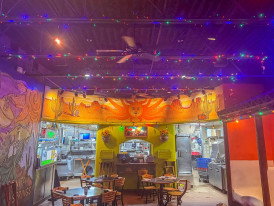
Small cantina interior with rainbow decorations
LGBTQ+ Friendly Cantinas Around Juárez's Quieter Strips
Zona Rosa became a tourist strip, but Colonia Juárez side streets host cantinas that welcomed LGBTQ+ customers decades before marriage equality. These places still serve the community while welcoming respectful visitors.
Respect note: Community spaces first, tourist destinations second. Order drinks, tip fairly, and understand you are a guest in someone’s social environment.
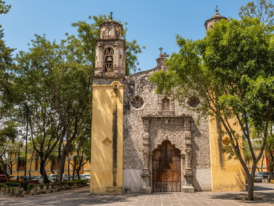
Plaza de la Conchita
Sunday Plazas Where Local Culture Actually Gathers
Every neighborhood has plazas, but not every plaza hosts genuine community life. I look for the ones where families actually gather on Sundays, teenagers flirt across benches, and old men argue about fútbol.
Plaza de la Conchita, the small one, fills with neighborhood families spreading blankets for informal picnics. These plazas function as outdoor living rooms where three generations spend Sunday afternoons.
For me, community spaces work when they serve community needs, not tourist expectations.
Los Dinamos follows a river valley through forests that feel completely separate from urban Mexico.
Where Can You Find Pine Trails Without Leaving the City?
We sit at high altitude, surrounded by mountains, which creates nature escape opportunities without major travel.
As a result, there are so many things to do in Mexico City that isn't all about food. I prefer trails that feel genuine, not theme park versions, and I recommend you check out the authentic spots first.
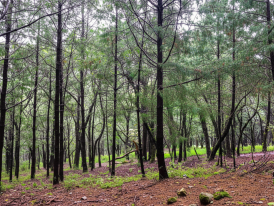
Pine forest trail at Desierto de los Leones national park
Desierto de los Leones National Park (Cool Air, Easy Hiking Trails)
Despite its name, Desierto de los Leones National Park contains no desert and no lions. What it does have are pine forests, mountain air, and hiking trails that remind you Mexico City exists in a high valley surrounded by wilderness.
I bring friends and visitors for the temperature change. Even summer feels 10 to 15 degrees cooler. Monastery ruins provide historical context, and the hiking trails offer real solitude.
Day trip logistics: About 45 minutes by rideshare. Bring layers for the temperature change. On weekend mornings, arrive early. Consider travel insurance for any national park hiking.
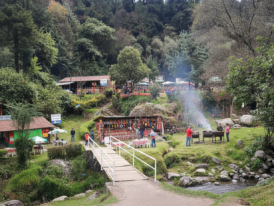
Families grilling food by the river in Los Dinamos
Los Dinamos River Walks: Market Grills and Mist
Los Dinamos follows a river valley through forests that feel completely separate from urban Mexico. Trails run parallel to the water through pine and oak, and the rush of the river replaces city noise.
On weekends, families set up grills near the water. Stream crossings add a bit of adventure, which appeals to teenagers who resist structured outdoor activities.

Audiorama in Chapultepec Park
Chapultepec Park Section 1: Audiorama and Secret Shade
Audiorama sits in the First Section of Chapultepec, tucked behind the Tribuna Monumental with entry by the Las Flores access. It's a small outdoor reading nook with benches and low-volume music played through speakers among the trees. Entry is free. Hours are Tuesday to Sunday, 9:00 AM to 4:00 PM. It is closed on Mondays with the rest of Section 1.
Weekday mornings are the quietest. Early Sundays are calm before the park fills later in the day. Bring a book, keep voices low, and treat it like a library in the woods.
Perfect for: Solo reading, a short mindfulness break, light stretching or quiet breathwork, and anyone who wants nature and silence without leaving the center of the city.

UNAM botanical garden with unique plants and cacti
UNAM Beautiful Gardens Among Lava Fields
UNAM’s campus spreads across lava fields from an ancient volcanic eruption, which creates unique botanical conditions. The university planted gardens that work with the volcanic soil, creating landscapes found nowhere else.
Students claim study spots under trees across the campus, creating an academic atmosphere visitors can join. For comprehensive information about exploring all of my city's experiences, UNAM showcases the country's commitment to education and natural preservation.
Travel Guides Can Only Take You So Far
We connect travelers with locals who shape days that actually fit your interests, not someone else’s checklist.
See how it worksWhich Archaeological Site Beats the Crowds?
Famous archaeological sites draw enormous crowds that make contemplation impossible. I prefer places where you feel history’s weight without fighting tour groups.
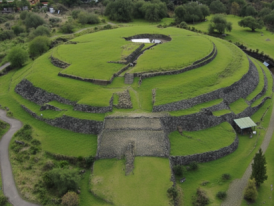
Round pyramid at Cuicuilco
Cuicuilco's Round Pyramid and the Lava Story of an Ancient City
Before Teotihuacán dominated, Cuicuilco thrived as a major ancient city. Then the Xitle volcano erupted, covering the settlement in lava. The round pyramid survived because of its height, creating a unique site where you can see the moment volcanic activity ended life here.
The circular design makes Cuicuilco unique among Mesoamerican pyramids. The small on-site museum explains the volcanic activity and how people lived here. The lava preserved evidence that disappeared at other sites.
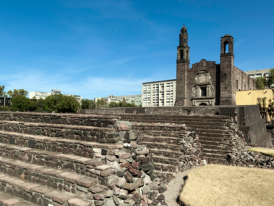
Plaza de las Tres Culturas
Tlatelolco's Layers (Plaza + Museum) With History You Can Stand In
Tlatelolco presents three layers of Mexican history in the same space. Aztec ruins form the foundation, Spanish colonial architecture occupies the middle, and modern Mexico created the Plaza de las Tres Culturas to acknowledge all three periods.
The Aztec market here competed with Tenochtitlan's famous market. The site ties into stories of the Aztec emperor Moctezuma and the power of commerce. Standing in the plaza, you see architectural evidence of conquest, adaptation, and cultural synthesis across more than 500 years.
What Should You Skip, or See Differently?
Some famous attractions earned their reputations, but popularity can interfere with the original experience. Guidebooks love the obvious gems in Mexico City, but hidden gems often come down to timing and micro-neighborhoods.
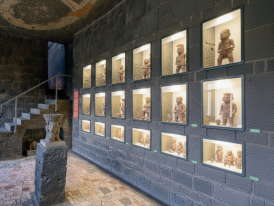
Anahuacalli museum interior display
National Museum of Anthropology → Anahuacalli
The National Museum of Anthropology houses the world’s largest collection of pre-Columbian Mexican artifacts. It is also the biggest attraction most visitors see, which creates crowds that make contemplation difficult.
Diego Rivera built Anahuacalli as a personal museum. The pyramidal building holds his extensive collection in spaces designed for intimate viewing without heavy crowds.
Keep: Architecture and anthropology students who understand the significance.
Tweak: Arrive when doors open or in the late afternoon on weekdays.
Alternative: Anahuacalli offers a more contemplative encounter with pre-Columbian culture.

Diego Rivera mural at SEP building
National Palace Murals → San Ildefonso or SEP
Rivera’s National Palace murals deserve their reputation, but viewing them means joining crowds that make appreciation difficult. The murals cover stairwells where groups create bottlenecks.
Rivera painted throughout Mexico City, including extensive work at the SEP building and at San Ildefonso. These locations offer comparable achievements without the crush. The SEP ground floor murals are accessible and show Rivera’s full range.
Keep: Art history students who need a complete Rivera survey.
Tweak: Go very early in the morning or late in the afternoon on weekdays.
Alternative: The SEP building and San Ildefonso provide better viewing conditions.

Quiet forest trails in Chapultepec Park Section 3
Chapultepec Castle → Section 3
Chapultepec Castle offers spectacular views and real historical significance, but weekend crowds turn the experience into waiting in lines.
The castle sits within one of the largest parks in Latin America, which offers plenty of alternatives. Section 3 has forested trails with equally impressive views and far fewer people.
Keep: History buffs who need Maximilian and Carlota context.
Tweak: Go on weekday mornings.
Alternative: The park’s sculpture gardens and forest sections often provide a better experience.

Rooftop bar Cabuya
Torre Latinoamericana → Rooftops Nearby
I've been a few times, and Torre Latinoamericana delivers true panoramic views, but lines can get in the way. Evening views with a drink make for a more relaxed experience.
Keep: Architecture enthusiasts who appreciate the building’s historical importance.
Tweak: Visit very early in the morning or later in the evening.
Alternative: Check out 191 Rooftop or Aleli for awesome vibes and even better drinks.

Quiet courtyard in Coyoacán
Coyoacán → San Ángel
Coyoacán’s weekend crowds turn cobblestones into slow-moving rivers of tourists. The neighborhood charm gets buried under the pressure.
San Ángel offers comparable colonial architecture without the crush. Art studios and galleries fill converted homes without tourist-trap pricing. To me, it feels like famous places become victims of success. Sometimes alternatives serve original purposes better.
Keep: Frida Kahlo devotees who need the Casa Azul pilgrimage.
Tweak: Go on weekday mornings for an authentic neighborhood feel.
Alternative: San Ángel provides the colonial atmosphere Coyoacán once offered.
Behind This Article? Not a Tourist.
Written by locals, not tourists. And they’re the same people you can explore the city with on our experiences.How Do Locals Move Between Gems?
Mexico City's size can be intimidating at first, but the Metro and a little planning make visiting several hidden gems efficient. I think in neighborhood clusters and natural movement patterns.

Buying bus tickets
Public Transit + Short Rideshare Hops That Make Sense
The Metro connects most recommended neighborhoods directly, and combining the Metro with short rideshare trips often makes more sense than fighting the system’s limitations.
Santa María la Ribera connects to downtown via the Metro, which is easy to combine with San Ildefonso or the SEP murals.
Roma Norte sits within walking distance of several stations. Step-free access is inconsistent across Metro stations. Check elevators in advance, or plan short rideshare hops between accessible stops.
Movement strategy: Plan by neighborhood clusters rather than individual attractions. Combine two or three gems per area before moving to the next zone.

Making change with cash
Cash vs. Card With Street Vendors and Local Markets
Most hidden gems run on cash. Street vendors, market stalls, and small pulquerías work with peso bills, not card terminals.
ATMs cluster around Metro stations, but not always near specific gems. Plan withdrawals around Metro stops rather than assuming you will find machines in residential neighborhoods.
If you have free time between neighborhoods, pause in a plaza instead of backtracking.

Evening scene at a neighborhood pulquería
Safety Windows at Night; Why Travel Insurance Is Adulting, Not Fear
Most recommendations are better during the day, but some neighborhoods offer good evening experiences with basic precautions.
Roma Norte and San Ángel maintain safe pedestrian activity through the evening. Travel insurance makes sense for big-city exploration, not because Mexico City is unusually dangerous, but because cities this size present normal urban risks.
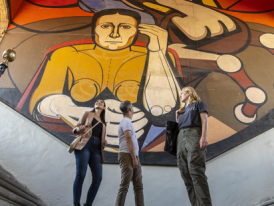
Visitors respectfully viewing wall murals
Respect Rituals: No Flash on Wall Murals, Ask Before Photos
Cultural sites function as active community spaces, not just tourist destinations. Photography etiquette varies by location.
Diego Rivera murals prohibit flash photography to preserve the paintings. Street vendors appreciate being asked before photos. Most say yes if you ask respectfully.
Moving efficiently requires understanding transportation systems and social expectations. For more day trips from Mexico City, consider combining urban gems with nearby natural attractions.
Google Can’t Answer This One
A local can, in a 1-to-1 video call tailored to your trip.
Frequently Asked Questions
1. Is It Safe to Explore Downtown Mexico City at Night?
Downtown Mexico City maintains active street life until 10 PM, especially on weekends. Stay on main corridors with lighting and pedestrian activity. Use rideshares after 10 PM. There are so many great things to do at night in Mexico City, don't miss out on it!
2. What Are the Best Non Touristy Things to Do With Kids?
Tianguis in Portales, plaza activities, and the glass walkways at Biblioteca Vasconcelos work well. Chapultepec Section 2 provides outdoor adventure without tourist crowds.
3. How Do I Plan a Day Trip to Lions National Park (Desierto de los Leones)?
Plan a half day at minimum. It takes about 45 minutes of travel in each direction, plus two to three hours on the trails. Leave early on weekend mornings, around 8 AM, for parking. Bring layers and water.
4. Where Can Chocolate Lovers Go in CDMX?
MUCHO Museo del Chocolate offers educational experiences. Traditional markets sell chocolate products that Mexican families use for cooking, not just tourist souvenirs.
5. What's the Easiest Guided Tour Alternative to See Diego Rivera Murals Without Crowds?
San Ildefonso and the SEP Building offer self-guided viewing without crowds. Both provide informational materials that explain the historical context.
6. Which Beautiful Parks Feel Local on Sundays?
Chapultepec Section 2 has a family atmosphere without tourist buses. Santa María la Ribera’s plaza creates neighborhood culture where generations gather.
7. Can I See Colonial Architecture Without the Tourist Areas?
San Ángel side streets showcase colonial architecture without Coyoacán crowds. Lava-stone walls and cobblestones create an authentic atmosphere.
8. Is Chapultepec Park a Large Park With Quiet Corners?
Chapultepec spans sections that serve different purposes. Section 1 focuses on cultural attractions. Section 2 is for families. Section 3 offers forest solitude.
9. What's a Good Archaeological Site Inside the City Limits?
Cuicuilco offers a unique circular pyramid and a volcanic preservation story. Tlatelolco demonstrates layered history in a single location.
10. How to Catch a Lucha Libre Night That's Low-Key?
Arena Coliseo provides a neighborhood atmosphere. Tuesday or Thursday nights focus on the sport rather than spectacle.
11. Are There Unique Places for a Short Yoga Session Outdoors?
UNAM’s botanical areas provide quiet spaces among beautiful gardens. Chapultepec Section 2 offers forest settings during the morning.
12. Tips for Visiting Tula as a Day Trip?
A full day is required with an early departure. Buses from the North Bus Terminal provide direct access. Guided tours are helpful for historical context.
13. Where to Find Fine Arts Beyond Bellas Artes?
San Ildefonso showcases fine arts in intimate settings. Small museums focus on Mexican design traditions with room for genuine appreciation.
14. What Are the Most Unique Things in Centro Historico That Locals Actually Do?
Morning coffee at traditional cafés, lunch at working-class fondas, and evening cultural events. The SEP murals and traditional cantinas serve local needs.
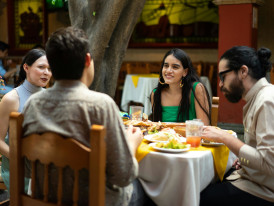
Local family sharing a meal at a neighborhood restaurant
Final Thoughts
These are the gems to look for when you explore Mexico City, the ones we actually use. They live in the rhythm between famous and forgotten, sustained by local communities, not by tourism. Some require Metro rides to neighborhoods that skip the guidebooks. Others hide in plain sight and only need different timing.
I have shared these places because they reflect what Mexico City residents actually experience, the spaces between monuments where daily life creates beauty. Visit with curiosity rather than conquest. Respect the communities that preserved these gems by arriving as a guest, not a discoverer.
When friends visit, these are the places I take them after the famous sites, when they want to understand how Mexico's experiences works. They are not hidden from locals, just overlooked by tourism that prefers spectacle over authenticity.
If you want someone to show you these corners in person, I sometimes host intimate groups that explore CDMX through local eyes. Honestly, the best way to discover these gems is to approach them with patience and respect for the communities that call them home.
The Mexico City that matters lives in these spaces. Welcome to my neighborhood.
More Mexico City Adventures
Ready to Plan Your Perfect Day in Mexico City?
Start your experienceWho We Are
City Unscripted helps travelers explore cities with locals: private, flexible days shaped entirely around you.
Wish you had a local friend in Mexico City?
One who knows the city inside out and could plan a private day just for you? Our local hosts do exactly that: no scripts, no tourist traps, just the side of the city most people miss.


